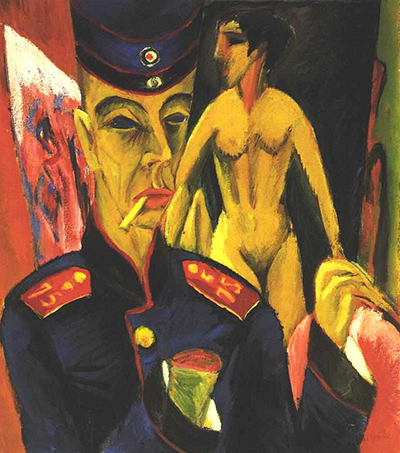Self-Portrait as a Soldier is one of Kirchner's most famous paintings and provides elements of symbolism, portraying the artist with an amputated hand.
This powerful piece from 1915 can now be found at the Allen Memorial Art Museum, Oberlin College, an small museum which contains some significant artworks besides just this one. You can also find the likes of Alexej von Jawlensky, Oskar Kokoschka, Karl Schmidt-Rottluff, Egon Schiele and Paul Klee. That list just focuses on their work from the Die Brücke movement plus related German artists, but many other movements are also addressed including the ever-popular periods of the Italian Renaissance. For a provincial collection in the US, it is particularly rare to find such an impressive collection of German art. Self-Portrait as a Soldier first arrived in the US in 1950 via an auction purchase and has remained there ever since, other than for the occasional exhibition loan.
The meaning of his injury in this painting is to signify how the war would damage his creativity, as if literally losing a hand. The mental and physical turmoil caused by going to war is impossible to imagine unless you have been through it yourself, and with Expressionist artists being so in tune with their emotions, the impact for them would be even more significant. The image of this painting is perhaps better at communicating these horrors than the words of even the finest war poet. Arriving in 1915, the artwork came about in the midst of WWI, a war that some believe to have been the worst of all in terms of the numbers affects and the types of warfare used.
Kirchner volunteered as a driver in the artillery in the hope of avoiding some of the truly terrible roles. He was soon deemed unsuitable to serve due to a number of health issues and was granted a reprieve, much to his obvious relief. Despite this short service, the impact of this environment left an indelible mark on his character for the rest of his life and this painting serves as an example of his inner turmoil. He was also very aware of this effect and was concerned about how it might stunt his future artistic work, which relied so much on his connections to his emotions. Research has uncovered the identity of his uniform, with it being the Mansfelder Feldartillerieregiment Nr. 75 in Halle/Saale. The nude woman behind him perhaps is a symbol of his previous work, which has now been left behind him due to his recent experiences that can never be undone.
This Kirchner painting can be found in the collection of the Allen Memorial Art Museum, in Ohio, USA. This institution may not be as famous as the major national art galleries of this country, but its collection is highly impressive and it is all on display within a stunning setting, featuring a style of architecture which would rarely be seen in this part of the world. Some of the highlights to be found here include Garden of the Princess, Louvre (1867) by Claude Monet, Viaduct at L'Estaque by Paul Cezanne (Georges Braque also completed similar scenes), View of Venice: The Ducal Palace, Dogana, and Part of San Giorgio by William Turner, Chair and Owl by Pablo Picasso and The Actor Iwai Kumetaro as the Kamuro Tayori from the Shimbara Di by Utagawa Kunimasa. The overall selection is far more varied than this, though, with many regions of the world covered, including some wonderful antiquities from different Asian and African civilisations.




